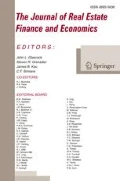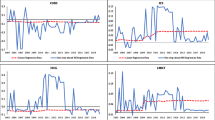Abstract
Recent evidence suggests that all asset returns are predictable to some extent with excess returns on real estate relatively easier to forecast. This raises the issue of whether we can successfully exploit this level of predictability using various market timing strategies to realize superior performance over a buy-and-hold strategy. We find that the level of predicability associated with real estate leads to moderate success in market timing, although this is not necessarily the case for the other asset classes examined in general. Besides this, real estate stocks typically have higher trading profits and higher mean risk-adjusted excess returns when compared to small stocks as well as large stocks and bonds even though most real estate stocks are small stocks.
Similar content being viewed by others
References
Campbell, John Y. “Stock Returns and the Term Structure,”Journal of Financial Economics, 18 (1987), 373–399.
Campbell, John Y. “A Variance Decomposition of Stock Returns,”Economic Journal, 101 (1991), 157–179.
Campbell, John Y., and Jianping Mei. Where Do Betas Come From? Asset Pricing Dynamics and the Sources of Systematic Risk, New York University Working Paper (1991).
Campbell, John Y., and Yasushi Hamao. “Predictable Stock Returns in the United States and Japan: A Study of Long-Term Capital Market Integration,”Journal of Finance, forthcoming.
Chang, Eric C., and Wilbur G. Lewellen. “Market Timing and Mutual Fund Investment Performance,”Journal of Business, 57 (1984), 57–72.
Chen, Nai-fu, Richard Roll, and Stephen Ross. “Economic Forces and the Stock Market,”Journal of Business, 59 (1986), 386–403.
Connor, Gregory, and Robert A. Korajczyk. “Risk and Return in an Equilibrium APT: Application of a New Test Methodology,”Journal of Financial Economics, 21 (1988), 255–289.
Cumby, Robert E., and David M. Modest. “Testing for Market Timing Ability: A Framework for Forecast Evaluation,”Journal of Financial Economics, 19 (1987), 169–189.
DeBondt, Werner, and Richard Thaler. “Further Evidence on Investor Overreaction and Stock Market Seasonality,”Journal of Finance, 42 (1987), 557–581.
Fama, E., and K. French. “Dividend Yields and Expected Stock Returns,”Journal of Financial Economics, 22 (1988), 3–25.
Fama, E., and K. French. “Business Conditions and Expected Return on Stocks and Bonds,”Journal of Financial Economics, 25 (1989), 23–49.
Fama, E., and G. William Schwert. “Asset Returns and Inflation,”Journal of Financial Economics, 5 (1977), 115–146.
Ferson, W. “Changes in Expected Security Returns, Risk, and Level of Interest Rates,”Journal of Finance, 44 (1989), 1191–1217.
Ferson, W. “Are the Latent Variables in Time-Varying Expected Returns Compensation for Consumption Risk?”Journal of Finance, 45 (1990), 397–430.
Ferson, W., and C. Harvey. “The Variation of Economic Risk Premiums,”Journal of Political Economy, forthcoming.
Ferson, Wayne, Shmuel Kandel, and Robert Stambaugh. “Test of Asset Pricing with Time-Varying Expected Risk Premiums and Market Betas,”Journal of Finance, 42 (1987), 201–219.
Gibbons, Michael, R., and Wayne Ferson. “Testing Asset Pricing Models with Changing Expectations and an Unobservable Market Portfolio,”Journal of Financial Economics, 14 (1985), 217–236.
Giliberto, S. Michael. “Equity Real Estate Investment Trust and Real Estate Returns,”Journal of Real Estate Research, 5 (1990), 259–263.
Glascock, John L. “Market Conditions, Risk, and Real Estate Portfolio Returns: Some Empirical Evidence,”Journal of Real Estate Finance and Economics, 4 (1991), 367–373.
Gyourko, Joseph, and Donald Keim. “What Does the Stock Market Tell Us About Real Estate Returns?” Working Paper, The Wharton School, 1991.
Harvey, Campbell R. “Time-Varying Conditional Covariances in Tests of Asset Pricing Models,”Journal of Financial Economics, 24 (1989), 289–317.
Henriksson, Roy D. “Market Timing and Mutual Fund Performance: An Empirical Investigation,”Journal of Business, 57 (1984), 73–96.
Henriksson, Roy D., and Robert C. Merton. “On Market Timing and Investment Performance. II. Statistical Procedures for Evaluating Forecasting Skills,”Journal of Business, 54 (1981), 513–533.
Jensen, Michael C. “The Performance of Mutual Funds in the Period 1945–1964,”Journal of Finance, 23 (1968), 389–416.
Keim, Donald B. “Size Related Anomalies and Stock Return Seasonality: Empirical Evidence,”Journal of Financial Economics, 12 (1983), 13–32.
Keim, D., and R. Stambaugh. “Predicting Returns in the Stock and Bond Markets,”Journal of Financial Economics, 17 (1986), 357–390.
Liu, Crocker, and Jianping Mei. “Predictability of Returns on Equity REITs and Their Co-Movement with Other Assets,”Journal of Real Estate Finance and Economics, 5 (1992), 401–408.
Liu, Crocker, and Jianping Mei. “An Analysis of Real Estate Risk Using the Present Value Model,”Journal of Real Estate Finance and Economics, forthcoming.
Mei, Jianping. “A Semi-Autoregressive Approach to the Arbitrage Pricing Theory,”Journal of Finance, forthcoming.
Mei, Jianping, and Anthony Saunders. “Bank Risk and Real Estate: An Asset Pricing Perspective,” Working Paper, New York University, 1991.
Nourse, Hugh O. “The “Cap Rate,” 1966–1984: A Test of the Impact of Income Tax Changes on Income Property,”Land Economics, 63 (1987), 147–152.
White, Halbert. “A Heteroskedasticity-Consistent Covariance Matrix Estimator and a Direct Test for Heteroskedasticity,”Econometrica, 48 (1980), 817–838.
Author information
Authors and Affiliations
Rights and permissions
About this article
Cite this article
Mei, J., Liu, C.H. The predictability of real estate returns and market timing. J Real Estate Finan Econ 8, 115–135 (1994). https://doi.org/10.1007/BF01097033
Issue Date:
DOI: https://doi.org/10.1007/BF01097033




